

Flutes from the second half of the 18th century and early 19th century (whether they were equipped with more than one key or not) often had slightly narrower bores than baroque flutes. Many flute makers made other subtle and not-so-subtle changes in the exact shape and taper of the bore, always striving to "improve" the flute according to the then current ideas and goals. In any case, the result of modifications in the bore and elsewhere in the design was that many of the classical flutes had easy high notes, including f''', and up to a''', and they could be very bright. A higher pitch contributed to the brightness.
It is difficult to describe in words this often bright sound of a classical flute, but in the best examples it is one of great charm. Of course, there was a gradual transition over time, and there is no sharp dividing line between baroque and early classical and late classical flute sound. My opinion is that English flutes circa 1800 retained more of the earlier 18th century sound ideal than did German flutes from that period, some of which are quite bright, and that the English flutes are not in general as easy to play in the highest part of the range (but there are exceptions).
Good flutes from the mid-18th century are very even and easy to play in tune. Some classical one-key flutes can be somewhat less even. It is dangerous to generalize, but on some (only some) late 18th century or early 19th century flutes, the forked fingerings for one or more of the first octave b'b, g'#;, and f' can be less resonant than on earlier flutes, and may tend to be sharp. It can take a bit more "work" to get a good sonority from the first octave, but with work, they can be relatively loud on most notes. It may be that compromises were made in the first octave in order to get a smooth and easy playing third octave, which became more important. Flutes were routinely expected to play up to g''', and the a''' became common in symphonic parts in the 1790–1800 period. (But music for the amateur market was often restricted to e''' and below in that period, as in the baroque era.)
The shape of late 18th century flutes is usually less ornate than that of mid and early 18th century flutes. The corps de rechange, screw-cork, and register were more common, but by no means universal.
Below is a copy, including the full corps de rechange, of a flute by G. A. Rottenburgh of Brussels. The copy is by Andreas Glatt. The date of the original flute is unclear, but a good guess is 1760 or later. The various center joints play at pitches of about A=398, 404, 410, 415, 422, 430, and 435.
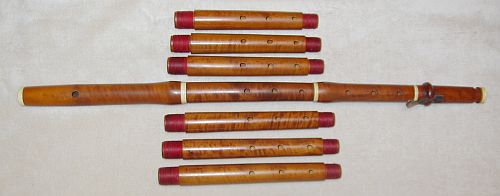
The flutes most often used in the preclassical and classical period (1750–1820, say) were one-key flutes. Mozart (1756–1791), for example, would have seen and known flutes with more than one key, but with the exception of his Flute and Harp Concerto K299 (which uses a few notes below d'), all of his flute parts fall within the capabilities of the one-key flute of his time, and it is likely that that instrument is what he expected to see and hear playing them.
Shown below are one-key flutes marked FLORIO/LONDON (c.1795), G ASTOR & Co/LONDON (c.1800), H. GRENSER/DRESDEN (c.1810), and GRIESSLING & SCHLOTT (c.1805). The Astor has a metal lined tuning head and originally had a pewter plug key (see below). The end caps on the Astor and Grenser are not original; and neither is the Griessling and Schlott head joint, which is a copy of the surviving but cracked original. The first two flutes are pitched at roughly A=437 when the head joint is all the way in. The last two have, or had, corps de rechange; the Grenser survives only with the shortest center, labeled '3'. The pitches of the G&S centers are roughly A=433, 438, 443, and the Grenser is at 443 or a bit higher.
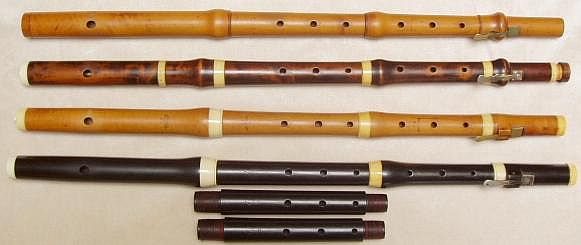
In the second half of the 18th century, extra keys were added to the flute. These were of two types: open-standing keys on an extended foot joint for notes below d', and closed-standing keys on the center joints used for notes outside the D major scale.
The material below pertains to the introduction of additional keys. Before continuing, we repeat that the most common flute until the very end of the 18th century, even among serious and professional players (let's say professional players outside of England), was the one-key instrument. It is possible that well-to-do amateurs would have been more likely to have fancy flutes with extra keys than the working professional. A flutist who wishes to accurately represent the instruments of the time should think twice about using a flute with more than one key for music written before 1790 or so, say, with the exception of music from England where the keys became popular first. (This does not mean a 'baroque flute' at a low pitch should be used for music of the 1790s.)
For a more detailed and precise description of the events, background, and individuals involved in the introduction of keys, one must read Chapter 6 of Ardal Powell's The Flute, Yale University Press, and the introduction and appendices to his translation The Keyed Flute, Oxford Early Music Series 17, of J. G. Tromlitz's 1800 essay on flutes with several keys. Discussions of these events in other books are less well researched (and, in some books and older sources, simplistic and even wrong).
Certainly there would have been many experiments where keys were added to the flute. We have mentioned the C-foot experiments circa 1720. Probably many other early experiments have not survived.
What we do know is that flutes with a C-foot and a total of six keys appeared in London as early as circa 1755, and that flutes so equipped were common and popular enough by 1770 that fingering charts for flutes "with the additional keys" were appended to English flute methods that otherwise addressed the one-key flute. (Click here to see the charts and diagrams.)
One might have expected to find the first surviving evidence of flutes with more than one key—other than the Quantz flutes and C-foot experiments mentioned in the section on baroque flutes—to be flutes with two or three or maybe four keys. But no, the earliest surviving English keyed flutes, from 1770 and before, have six keys and the earliest English sources that refer to multi-keyed flutes mention six keys. There are 18th century flutes with fewer than six keys, but in England one can imagine that this was a retrograde step. Flutes were provided with fewer keys—usually four, and with only a D-foot—to save expense. (However, another reason for not equiping a foot with a C-foot was because of fundamental objections to the effect of the extra length on tone, technique, or esthetics, by some players or makers. One compromise was a foot with an extension to C# only.)
The earliest six-keyed English flutes looked something like the flute in the following photograph. (The instrument shown is stamped PARKER/LONDON and was probably made about 1800. Its pitch is just above A=440.)
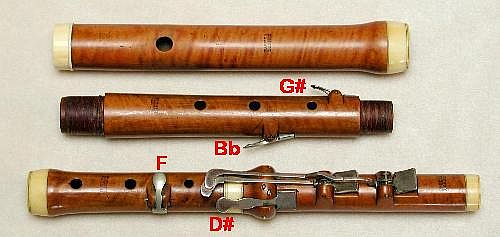
Three keys can be seen on the foot joint, one on the lower center, and two on the upper center. The foot joint extends to c', and there is a key for c'#; as well. The holes for d' and c'#; remain open until one or both of these keys are depressed by RH4. The D# key is as on the one-key flute. The other three keys produce the notes F, G#, and Bb, respectively, when the finger holes above them are closed but the key is opened.
Early features on this flute that are not found on most English flutes after 1800 or so (but there are exceptions) include the minor decorative notches on the key touches on the foot joint, and the 'vaulted' shank of the low C key, which passes over the C# key flap and not around it. The key shown on the left below is the G# key; the F key visible in the photo above is a 19th century replacement for a damaged or lost key. It is a simpler style and is nickel silver instead of silver.
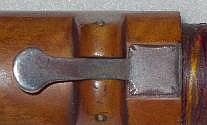
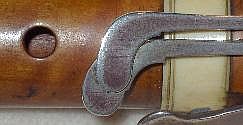

The keys on the footjoint are open-standing and extend the reach of the fingers. They act like fingers: fingers are moved down to close a hole and lifted to open a hole; with the key, a finger presses on the touch to close a hole and is lifted to open the hole. The finger presses a key touch instead of an open hole. Keys of this type are found on large renaissance wind instruments, including some bass and larger recorders. The keys on the foot joints of flutes to provide notes below d' have always been of this type, on all systems of flutes.
The closed-standing keys provide the real innovation. The D# key was the start of this closed key system. The small keys allow the notes outide the D major scale to be sounded without forked fingerings, so that they could be played more loudly and with a quality more nearly matching the ordinary notes. This was the initial reason for the introduction of the keys: increased volume (especially in the first octave) and evenness. The keys could also ease intonation difficulties for the notes outside D major, but this cannot be considered the primary reason they were first provided. Later, closed keys would be used for other purposes, like alternate fingerings, and some would be added to improve certain trills.
On the early English keyed flutes, the only first octave note that still required a forked fingering was c''. But there were no fingers readily available for a c'' key. And the note c'', fingered -23---, was found more acceptable than, say the softer b'b. Also, the fingering -2-456 with the D# key was coming into use at the end of the 18th century, and with this fingering the c'' could be played louder and, on some flutes, with a relatively reedy sound. Eventually a c'' key was found necessary, but it would take a number of decades to figure out how it should be implemented. An early form, claimed by J. H. Ribock as an invention of his (before 1782), is shown below (the key on the left; the key on the right is for Bb).

Use of the keys required new technique. Especially the F key, where a finger (RH3) had to be moved sideways; until then fingers moved only up and down. The one-key flute fingerings were easier to use in passagework. It is conceivable that a flutist working circa 1800 might have used a keyed flute for chamber work or solos, where strong low notes might be important, while using a one-key flute in the orchestra, where the keys were of little importance for the high notes.
In 1785, the London maker Richard Potter patented a number of innovations for the flute. Of major importance was the tuning head. We have seen that tuning heads were used on flutes in the mid-18th century, but they were entirely of wood. Potter chose to make the head in two parts, the main section and the barrel joint, both of which were completely lined with brass. The brass lining of the main part of the head extended beyond the wood, and the tuning barrel slid on the brass tube. The photos below show various position of the tuning barrel and the head joint proper, on a 6-key Richard Potter c.1790.




The engraved lines (rings) on the tenon part of the barrel joint are to help the player remember the prefered settings. They are numbered. Position number 6 is when the head is closed up completely; position number 5 is the first line (the second photo above); position number 4 is the second line. (The other line is not numbered.)
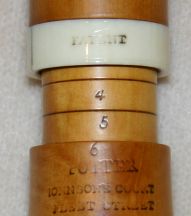
The pitches of this particular flute are approximately A=437 at position 6, A=432 at position 5, A=427 at position 4. The flute seems to play best at position 5. Presumably, the unused numbers 1,2,3 refer to obsolete, lower pitches that this flute was not designed to play at.
Potter also numbered lines on the indicator of the screw-cap, to help the player put the cork in the correct position. When the tuning head is withdrawn to the '4' position, the indicator is to be flush with the surface of the end cap; note the number 4 on the tip of the indicator in the photo below. The two lines (rings) on the indicator are numbered 5 and 6, though it is difficult to make the numerals out in the photo.
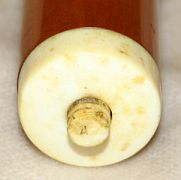
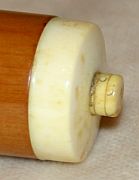
(Some earlier English six-key flutes, without tuning heads, had a three piece corps de rechange with joints numbered 4, 5, 6, and the same numbers on the indicator of a screw-cork. The center joint makered '5' was 'concert pitch' according to the descriptions accompanying fingering charts.)
Potter made his keys with (Potter's patented) pewter plugs. Rather than use leather on the flaps of flat key covers, he lined the holes with metal and attached soft metal plugs loosely to the key shanks. See the photos below. These are sometimes noisy, but a little oil (which must be cleaned off and refreshed regularly) helps to keep them quiet.
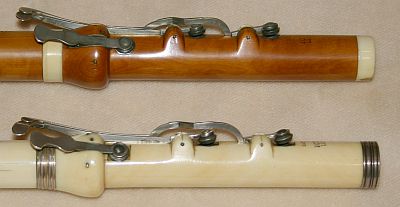
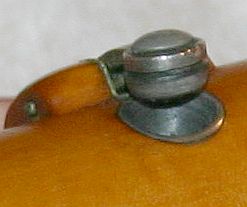
Pewter plugs are sometimes criticized for not working well. But the keys on the above instrument work just great, after more than 200 years. No padded keys are likely to keep working so long! It is true, however, that if the plugs are slightly damaged or corroded, they are very difficult to repair or adjust, and since this has happened to the plugs on numerous old flutes, they have the unfair reputation of being troublesome. Other makers took up and sometimes used pewter plugs, and they are not uncommon on English and Viennese style flutes throughout the 19th century. The plugs were often used on the open-standing foot joint keys, where soft pads were especially unreliable.
Potter's ideas were taken up in Vienna, but French and German style flutes do not have tuning heads or use pewter plugs in the late 18th or early 19th centuries. Tuning heads did become standard on all but the cheapest level of flutes in all counties later in the 19th century.
The flute shown on the home page of this site is a 10-key Stephan Koch, from Vienna, circa 1815, with a tuning head and pewter plugs on all keys.Outside England, there was great skepticism in the classical period about the value of the C-foot. The C-foot was almost completely ignored in France before 1820. There have always been (conservative) players who claimed that the C-foot ruined the tone and intonation. (This was later to be said about the B-foot on the Boehm flute.) In fact, unless the flute is redesigned (with bore and possibly hole position changes), there is a possibility that a longer foot joint will create changes in playing characteristics.
We remark that there are a number of flutes with two keys (other than C-foot or Quantz-style baroque flutes) that survive from the late 18th and 19th centuries, and that the second key is almost always a G# key. This is the note that was thought to most need a key.
Keyed flutes were made in Germany by J. G. Tromlitz circa 1781. (Tromlitz, like Quantz, advocated distinct keys for D# and Eb.) Several ideas for keys would appear to have originated with Tromlitz or other German makers, including the long F key (Tromlitz, 1786), keys for c'' (e.g. Ribock's key), and a second kind of Bb key; see below.
When keyed flutes are first mentioned in France (e.g. in the methods of Devienne and of Hugot and Wunderlich, in 1794 and 1804, respectively), it is a 4-key flute that is described, with a D-foot, and keys for D#, F, Bb, and G#.
Some German and a few French instruments were supplied with two foot joints, a D-foot with a single key, and a longer C-foot with three keys. The instrument shown below is stamped FREYER/BERLIN. Freyer died in 1805, but it is possible that the firm continued to use his stamp for some time after his death. Curiously, it is in a case labeled Griessling & Schlott. Included along with a three joint corps de rechange are both a D-foot stamped FREYER (second from the right, attached to the lower center) and an unstamped C-foot (on the left).
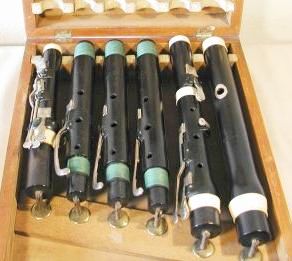
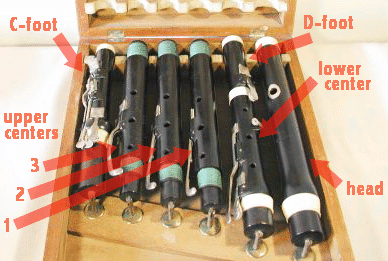
While it has been said that the D-foot often works better on an early flute, on this instrument—in its current condition—the two foot joints work pretty much the same, though I prefer the C-foot because of the balance.
The F key required RH3 to be moved sideways, away from hole 6. It is almost impossible to slur or move quickly from D to F without an intervening E being heard, or a pause, in the first two octaves. To alleviate this problem, an extra key for F, or an extra lever to control the F hole, was introduced and given to LH4. The touch was close to that of the G# key. This was called the long F key; the original key being the short F key. Still, not all problems were solved by this arrangement. For example, the sequence D-F-Ab was almost impossible to do with the keys, no matter whether the long or short F key is used.
The photos below show both the new long F key for LH4 as well as the original short F key for RH3 on the lower center joint of a boxwood flute by W. Liebel (Dresden, c.1825) and the ebony flute by Freyer (Berlin, c.1805). The upper photos are from the top, and the lower photos from the audience side.
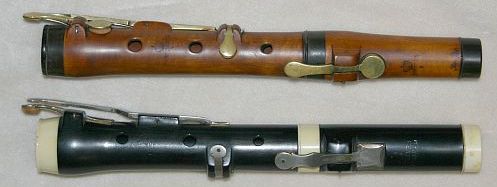
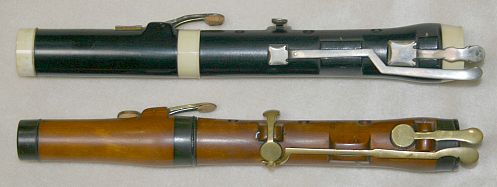
The Freyer has two separate F-holes and two separate keys to control them. The Liebel has one F-hole controlled by a construction with two key touches. One may call the long F key a Tromlitz lever because Tromlitz used this idea. (I still like to say the Liebel has two F keys when counting. I think it misleading to insist, as some do, that it has one F key just because it has one F hole.)
Several ideas for producing c'' from its own tone hole appeared before 1800. A tone hole and key for c'' raises a problem already present with the F keys: there is no unused finger that can be assigned to control it. The hole for c'' would be between the first and second finger holes. The left hand thumb is the obvious choice, but that digit was needed for the Bb key. Nevertheless, perhaps the earliest efforts to introduce a hole for c'' did give its control to the thumb. The photos below show copies of flutes by H. Grenser (Dresden, c.1800) and J. G. Tromlitz (Leipsig, c.1785) made by Folkers & Powell.

The H. Grenser has only an open hole for c'', that must be kept closed by the thumb unless c'' or c''' is wanted. The key for Bb is given to RH1. The open hole works great. But I miss the thumb Bb key; it is not always easy or possible to use the key for RH1. On the Tromlitz flute (equipped with the keys he described in 1800), the c'' hole is covered with an open-standing key. This key would be no better than the open hole, except that it allows the thumb to more easily control two keys, the second being a second key, closed-standing, for Bb. Though it takes practice to rotate the thumb from one of its keys to the other, this is really a very fine design.
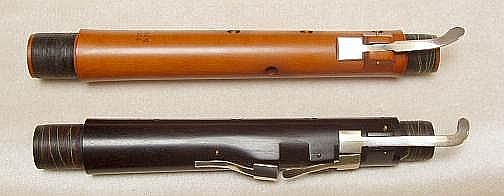
The left hand thumb-controlled C hole was not adopted on the simple system flute (though that is exactly what Boehm chose for his system). Two other ideas, both of which survived throughout the 19th century, can be seen below. On the boxwood flute by S. Koch (c.1815) below, there is a key on the back for use with the base of LH3. On the ebony flute by I. G. Freyer (c.1805), there is a long key for RH1. The arrows point to the pewter plug and flap of these C keys. This latter key is the type of C key that became standard, or at least was by far the most common, in the 19th century. It was described in a patent by the London maker Monzani in 1807, but probably anticipated by Grenser, Kirst, and other makers a few years before that. Still, it is safe to say that the long C key was essentially unknown before 1800.
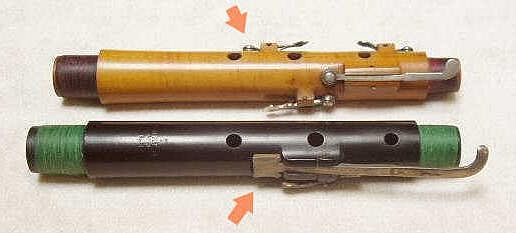
The long C key was not used very often; it never became the standard fingering for c'' or c'''. It is awkward to pass from c'' with that key to d'', for example. It was used for C/B trills and when C was the high note in a figure or phrase.
Closed-standing keys for c'' for the left hand thumb may be found on some 19th century flutes (e.g. by Streitwolf and Nonon). An unusual flute by Pentenrieder, c.1845, has a c'' key for LH4, with a touch next to the G# and long F key touches.
The alert viewer may have noticed that the G# key is sometimes mounted on the upper center joint (on the English flutes and Viennese flute shown above) and sometimes on the lower center (on the German flutes on this page). The G# key should ideally be placed almost exactly where the socket and tenon meet. The possible compromises are to make the G# hole small and move the G# key up to the upper center, or make the G# hole large and put it on the lower center. Different countries chose different solutions. One reason German flutes have the G# on the lower center is that the corps de rechange was still very popular there until c.1820, and with the G# on the lower center, it did not have to be replicated on each of the upper center joints. But soon the G# key would be found on the upper center on the flutes of all countries.
The size and position of the G# hole affects some of the fingerings used in the 19th century. A classical flute with the G# on the lower center is not suitable for playing music after about 1820, if all the advice and alternate fingerings that appear in flute methods of Drouet, Fürstenau, Tulou, Nicholson, etc., are to be followed.
We will leave further discussion of keys used on the simple system
flute until the next section on 19th century keyed flutes.
But we must mention that there were experiments and likely
a number of flutes made with an extended foot and extra key for low b
before 1800, probably in Vienna and perhaps elsewhere.
A pamphlet published by Orazi in Rome in 1797
contains a diagram of a flute with an extended
foot with keys down to g below middle c'. It is not clear
that this is a diagram of a real flute, but such flutes
were made in Vienna well before 1820.
